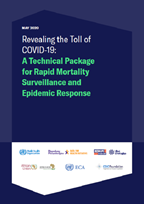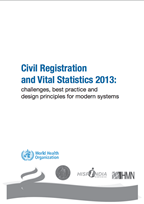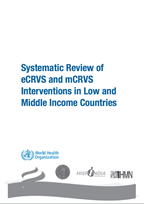- Data/
- Data collection tools/
- Civil registration and vital statistics (CRVS)
Civil registration and vital statistics (CRVS)
A well-functioning civil registration and vital statistics (CRVS) system registers all births and deaths, issues birth and death certificates, and compiles and disseminates vital statistics, including cause of death information. It may also record marriages and divorces.
Background to CRVS
Despite the well-documented benefits of CRVS, many countries do not have adequate systems in place. The births of tens of millions of children are known to be unregistered every year, and it is estimated that two-thirds of deaths are never registered and are thus not counted in the vital statistics system.

Critical gaps remain in birth, death & cause of death data. WHO’s civil registration plan can help
Health sector and civil registration: Role of the health sector in CRVS strengthening
A well-functioning Civil Registration and Vital Statistics System, better known as CRVS, uses inputs into and exits from a population register to provide governments with critical information on their population by age, sex and location, on which to develop policies and plan services. Good public health decision-making requires timely, reliable and actionable data on births and deaths, including cause of death, collected through these systems.
CRVS partners are encouraged to join forces towards the implementation of the WHO CRVS strategic plan, so that together everyone is counted because everyone counts.
This video by the World Health Organization describes how linking the health sector to the civil registration authority can lead to Universal Civil Registration for Universal Health Coverage.
CRVS tools and resources
Overview
The WHO CRVS Strategic Implementation Plan 2021-2025 aims to empower Member States to more effectively mobilize their health sector to lead, or contribute to, CRVS system strengthening efforts in order to ensure maximum benefit from routine data systems for policy and development. The Implementation Plan avails detailed guidelines that outline how this might happen in practice and what Member States need to consider when implementing health-related CRVS strengthening activities.
Overview
This guidance aims to support health-related programme managers and civil registrars as they define strategies to strengthen CRVS systems and leverage global and regional initiatives aiming to achieve universal registration of births, deaths and stillbirths. The guidance is based on the premise that the health sector can play a proactive role in ensuring that births and deaths are officially registered by national civil registration systems. This follows because vital events such as births and deaths often take place within a health institution; health workers are in contact with people at key moments in the life course – at the time of birth and at the moment of death.
The guidance describes the mutual benefits that would accrue to individuals and societies from enhanced collaboration between civil registrars, health entities and other stakeholders with a role in vital statistics. It describes some common scenarios in which births and deaths occur and outlines key steps that health workers can take to enable them to be registered.

Medical certification, ICD mortality coding, and reporting mortality associated with COVID-19
This technical note describes medical certification of cause of death and classification (International Classification of Diseases [ICD] mortality coding)...

Revealing the toll of COVID-19
The number of COVID-19 related deaths has become a key indicator to track the impact of the pandemic in countries and across the world. However, this number...

The World Health Organization (WHO), working with the University of Queensland in Australia, developed a comprehensive guide to support countries who wish...

Civil registration systems are used to record vital events – including births, deaths, and marriages – and have the potential to serve as the...
Publications
Monitoring of vital events (MOVE-IT)
MOVE-IT was implemented in 2011 and aimed at improving monitoring of vital events – births, deaths and causes of death – through innovation and the use of information technologies in innovative country projects.
The three reports listed below were commissioned on the MOVE-IT initiative and have been published to share the progress and results of these country projects and the lessons for future monitoring of vital events.

Civil Registration and Vital Statistics 2013: challenges, best practice and design principles for modern...
Within the domain of public health, information obtained from civil registration and vital statistics (CRVS) is critical, allowing tracking of individual...

In 2008–2009, the Health Metrics Network (HMN) funded a set of projects from different countries, with the common theme of applying the innovative...

Systematic Review of eCRVS and mCRVS Interventions in Low and Middle Income Countries
The problem addressed in this systematic review is concerned with the broad domain of information systems (IS) for Civil Registration and Vital Statistics...


